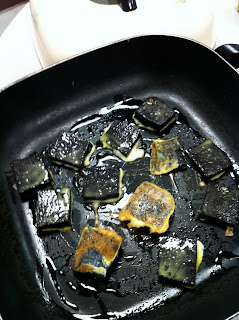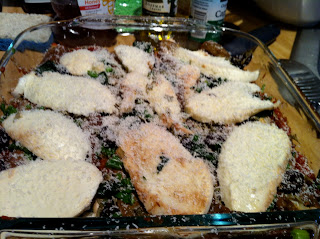In my previous post, I detailed my first attempt at making a Cantonese year cake using black glutinous rice, regular rice, sugar, and cassia flower. The cliffhanger at the end may make you wonder what other journey this year cake would take. Obviously, we all know its final destination (Part toilet, part released as carbon dioxide and water, part converted into energy...), but the journey to the destination is just as fun, and if not more important, than the destination itself (because this is a path function, not a state function damn it!). For this type of year cake, there are 2 conventional processing options: pan-fried (see this. Translated version here.) and fried (see this and this. Translated versions here and here. I have to try the taro/sweet potato trick some time because that sounds really good). My (deceased) grandma, and by extension my mom, both make pan-fried year cake the same way as the pan-fried recipe described. Childhood nostalgia always taste better than anything else.
My recipe is pretty much the same way as described in the translated version of pan-fried year cake, though I arrived there via a different path (passed down by my mom, or mostly just by watching her make it over the years). Here’s a group shot of all the ingredients:
1 ~4” x 4” x 2” block year cake (I used my black glutinous rice year cake with cassia flower, but you can use store-bought sweet year cake)
1 egg
Approx. 1 tablespoon oil
I used extra virgin olive oil here because that’s what I have on hand. As a general rule of thumb, you do not use extra virgin olive oil for pan-frying because it has a low smoke point (see here for various oil smoke points. Pay special attention to ghee, peanut oil, palm oil, coconut oil, and palm oil. All these oils are commonly used in Asian cuisine and they all have very high smoke points... that’s another post).
I cut the year cake into several ~2” x 2” x 1/4” pieces, and beat the egg. Here’s another family photo with everything prep up.
If you look very closely, you can see the light whitish spots on the year cake. I was referring to those spots when I talked about the hydration issue in my last post.
I’m using an electric skillet for this work. That just happens to be what I had on hand. As you can see the pan is teflon-coated, but the coating is scratched up. This may cause sticking. First, some oil inside a medium-high heat pan...
Next, I dipped the year cake piece by piece into the beaten egg and placed them in the pan. No pictures for that because I don’t want my phone to get salmonella....
This shot shows the dipped year cake inside the pan in various flipped states.
Pieces on the outskirts hadn’t been flipped yet, so they glistened in beaten egg nirvana. The center pieces had been flipped. As you can see, flipping forms a nice caramelized egg layer on the bottom. Some year cake pieces did not adhere too much of the beaten egg though. This is a common problem. The adhesion relates to the viscosity of the beaten egg and the year cake’s surface roughness. The fresh part of the egg whites usually has a higher viscosity than the rest of the egg, so it will cling onto the year cake better. At the end of the egg-dipping, I had a little bit of beaten egg left, so I just added it right on the year cake in the pan. I really like extra eggs on my year cake so that worked out really well.
Here’s the finished shot.
Because of the beaten egg, the year cake picked up a nice layer of char on top. The egg provided some extra crunch and caramelized protein flavor to the sweet, chewy contrast of the year cake. It’s almost as good as fried year cake, although as I mentioned earlier, nostalgia tastes better than fresh experience. A dash of salt in the beaten egg can bring this concoction to a new level of tastiness.
Bon appetit!
Notes:
1. You can just pan-fry the year cake, but it won’t taste as good because it won’t pick up char like the egg would. In my opinion, you cannot skip the egg (sorry true vegetarians...)
2. As for how long the pan-frying should take, it depends on when the egg is cooked and when the year cake is warmed throughout. A thicker slice or year cake just out of the fridge will also take a longer time to heat through. Adjust the heat accordingly so you can get the egg coating to cook and the year cake to heat through.
3. I really like a higher egg to year cake ratio, so I cut my year cake a bit thinner at the expense of having less of a chewy center. That’s a personal preference though, and you can cut it however thick you want, but I wouldn’t go too much more than 1/2” thick due to heat transfer issues.
4. I would use teflon pan for this application since it can reduce the amount of oil needed for the dish. If you’re against teflon, use more oil, and be patient when it comes to flipping. The pieces should detach from the pan when they are cooked.
My recipe is pretty much the same way as described in the translated version of pan-fried year cake, though I arrived there via a different path (passed down by my mom, or mostly just by watching her make it over the years). Here’s a group shot of all the ingredients:
1 ~4” x 4” x 2” block year cake (I used my black glutinous rice year cake with cassia flower, but you can use store-bought sweet year cake)
1 egg
Approx. 1 tablespoon oil
I used extra virgin olive oil here because that’s what I have on hand. As a general rule of thumb, you do not use extra virgin olive oil for pan-frying because it has a low smoke point (see here for various oil smoke points. Pay special attention to ghee, peanut oil, palm oil, coconut oil, and palm oil. All these oils are commonly used in Asian cuisine and they all have very high smoke points... that’s another post).
I cut the year cake into several ~2” x 2” x 1/4” pieces, and beat the egg. Here’s another family photo with everything prep up.
If you look very closely, you can see the light whitish spots on the year cake. I was referring to those spots when I talked about the hydration issue in my last post.
I’m using an electric skillet for this work. That just happens to be what I had on hand. As you can see the pan is teflon-coated, but the coating is scratched up. This may cause sticking. First, some oil inside a medium-high heat pan...
Next, I dipped the year cake piece by piece into the beaten egg and placed them in the pan. No pictures for that because I don’t want my phone to get salmonella....
This shot shows the dipped year cake inside the pan in various flipped states.
Here’s the finished shot.
Because of the beaten egg, the year cake picked up a nice layer of char on top. The egg provided some extra crunch and caramelized protein flavor to the sweet, chewy contrast of the year cake. It’s almost as good as fried year cake, although as I mentioned earlier, nostalgia tastes better than fresh experience. A dash of salt in the beaten egg can bring this concoction to a new level of tastiness.
Total elapsed time: about 10 - 15 min
Notes:
1. You can just pan-fry the year cake, but it won’t taste as good because it won’t pick up char like the egg would. In my opinion, you cannot skip the egg (sorry true vegetarians...)
2. As for how long the pan-frying should take, it depends on when the egg is cooked and when the year cake is warmed throughout. A thicker slice or year cake just out of the fridge will also take a longer time to heat through. Adjust the heat accordingly so you can get the egg coating to cook and the year cake to heat through.
3. I really like a higher egg to year cake ratio, so I cut my year cake a bit thinner at the expense of having less of a chewy center. That’s a personal preference though, and you can cut it however thick you want, but I wouldn’t go too much more than 1/2” thick due to heat transfer issues.
4. I would use teflon pan for this application since it can reduce the amount of oil needed for the dish. If you’re against teflon, use more oil, and be patient when it comes to flipping. The pieces should detach from the pan when they are cooked.




















































